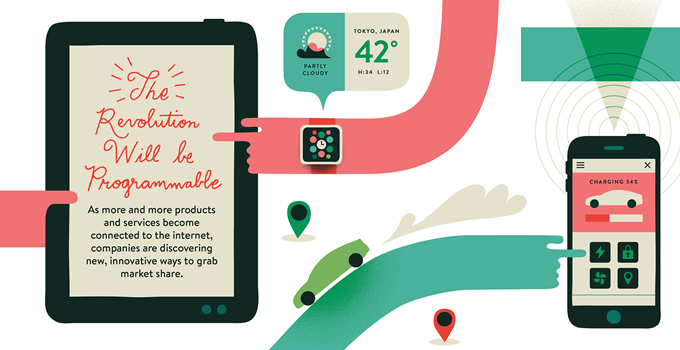
By CHERYL SOOHOO | ILLUSTRATION BY NATE LUETKEHANS
If the predictions pan out, the estimated 25 billion devices around the globe that currently connect to the Internet will double in number by the year 2020.Embedded with sensors, products continue to enter the marketplace with increasingly higher IQs. Today, smart cars, homes, electrical grids, treadmills and other devices enhance our lives and personalize our experiences. Via a broadband network, these “smart things” communicate not only to people but also to each other (machine to machine or M2M).
Hyperconnectivity is upending every facet of society. Smart objects are transforming business practices in health care, utilities and transportation, to name a few industries. At the touch of a screen, intelligent devices are linking consumers to services that only exist because of wireless communication. And innovators from every quarter are taking advantage of ubiquitous connectivity to create, usually by happenstance, new marketplaces.
Entrepreneurs are also taking advantage of digital technology to bring together buyers and sellers in new ways. This trend has seriously disrupted traditional business models, according to Mohanbir Sawhney, McCormick Foundation Chair of Technology, di-rector of Kellogg’s Center for Research in Technology and Innovation and clinical professor of marketing. “In our on-demand economy, every service in the future will be enabled by a smartphone or other smart device,” says Sawhney.
 Disruption happens
Disruption happensAs Kellogg teaches, innovators first must create strategies that solve problems and offer superior customer experiences before anything else.
“Startups need to build an MVP, test the market and custom develop their products with customer feedback,” says Daniel Kellmereit ’05, CEO of Detecon Inc., a San Francisco-based consultancy specializing in long-term digital strategies and co-author of The Silent Intelligence, a book about the Internet of Things phenomenon. “There’s no master plan for digital disruption. It’s more an evolution that is accelerating every day, and new market entrants often have an advantage against established players because they can build without legacy infrastructure and complex organizational boundaries.” From its inception, Tesla Motors embraced the credo of developing outstanding high-performance electric vehicles to support sustainable transportation.
Competing against large luxury sedans, the Tesla Model S has wowed auto industry experts with its speed, handling, ride and unique over-the-air updates. Similar to a smartphone, Tesla vehicles receive upgrades via the Internet rather than at the dealer service center. The Palo Alto, California-based firm sends out software fixes to improve functionality, from enhancing acceleration by fine-tuning the algorithms that drive the motor to alerting drivers that their car may be running out of juice. This sophisticated level of connectivity has truly distinguished the company in the auto industry — but that is just how Tesla has rolled from day one.
“Tesla was born in Silicon Valley,” says Diarmuid O’Connell ’96, the company’s vice president of business development.
“Connectivity between the individual and hardware is core to us.” Building “platforms” rather than cars, Tesla can refresh, improve and extend the lives of its vehicles and in part, fulfill the startup’s sustainability mission.
Increasingly, Internet-connected cars have become more akin to large mobile devices than simply a mode of transportation. This concept of computers on wheels will only grow, predicts O’Connell. “Mobile connectivity is challenging people’s assumptions about what cars are and what they are truly capable of providing users.”
Revitalizing antiquated industries
Using metal wires and brackets to straighten crooked teeth has been around since ancient times. And while metal braces remain the treatment method of choice, Align Technology, the market leader of clear plastic braces, has steadily chipped away at that traditional market with untraditional tools.
“There’s no master plan for digital disruption. It’s more an evolution that is accelerating every day. ”
Daniel Kellmereit ’05, CEO of Detecon Inc.
First, the San Jose, California-based company introduced the Invisalign system, a novel technique for aligning teeth predictably while providing a more comfortable feel and an aesthetically pleasing look. And rather than having an orthodontist adjust the braces by hand, computers custom-fit these devices to patients.Daniel Kellmereit ’05, CEO of Detecon Inc.
“We have fused cutting-edge 3-D scanning software with science to bring orthodontics to the next level,” says Tom Prescott ’92, who retired as president and CEO in June, but remains on the board of directors. “With digital scanning, dental professionals can virtually model an individual’s teeth and bite with greater precision — a much better value proposition for patients.” The process works like this: A doctor uses an intraoral scanner to create a digital 3-D model of the patient’s teeth. That file is then sent to Align, who works with the doctor to create a set of clear “aligners” that are manufactured to the doctor’s specifications using 3-D printing.
Now, more and more dental practices consider digital scanners a must-have, like ditching a slide rule in favor of a calculator. Align Technology foresaw this trend, acquiring intraoral scanner company Cadent in 2011 and leveraging its iTero scanner to further drive adoption of Invisalign treatment.
“Digital technology is quickly changing dentistry forever,” says Prescott. “Sometimes it takes generational change for innovations to become the standard of care, but I am confident Invisalign clear aligners will do just that in the next five to 10 years.”
Updating existing business models
Online sales continue to expand into the traditional brick-and-mortar retail market. In the beginning, desktop computers provided the first electronic shopping carts. Now mobile devices — tablets and smartphones — are becoming trusted shopping venues.
A leader in video and e-commerce retail, QVC quickly jumped on the e-commerce bandwagon in the late ’90s. As of the first quarter of 2015, online orders accounted for 42 percent of consolidated revenue for the West Chester, Pennsylvania-based company. At first, QVC worried that Internet shopping would cannibalize its broadcast retail sales efforts, but instead it has found a happy medium.
“It turned out our TV programming reinforced the comfort level of our audience with buying online and helped to establish credi-bility for the e-commerce category,” says Mike George ’85, CEO and president. “Even 10 years ago, there was a fear factor about having to supply credit card information electronically.” Storytelling across platforms and creating shared experiences via social media (Twitter, Instagram, blogs and Facebook) allows QVC to engage its core audience: 35- to 65-year-old females.
Meanwhile, mobile apps have gained traction with QVC customers. Mobile commerce accounted for 52 percent of global ecommerce orders, as of the first quarter of 2015, and QVC is ranked as the third largest mobile commerce retailer among multicategory retailers and fifth across all industries, according to the 2015 Internet Retailer Mobile 500 database.
“With two clicks using the iPhone app, for example, our customers can quickly purchase items they see on air,” says George. “It’s a frictionless way to shop.”
Bigger connectivity picture
As the connectivity of smart things transforms business models and creates new markets, the possibility of smart cities and even a smarter planet seems to be on the horizon. But to what end and for whom?
Channeling the power of connectivity in ways that benefit society as a whole will take widespread participation — from innovators, policymakers, consumers, educators and advocacy groups, all of whom must help shape the beneficial uses of digital technology, according to Sonita Lontoh ’06, head of global marketing at Trilliant, a Silicon Valley company specializing in the smart energy sector.
“There continues to be too much of a focus on gadgets and apps and not enough on systems and platforms to translate data into insights and, most importantly, into actions that improve efficiencies and result in a better way of living,” says Lontoh, an Internet of Things expert. “A connected world is a journey and not a destination. Technology is just a means to how we, as a society, can lever-age it for a greater good.”


